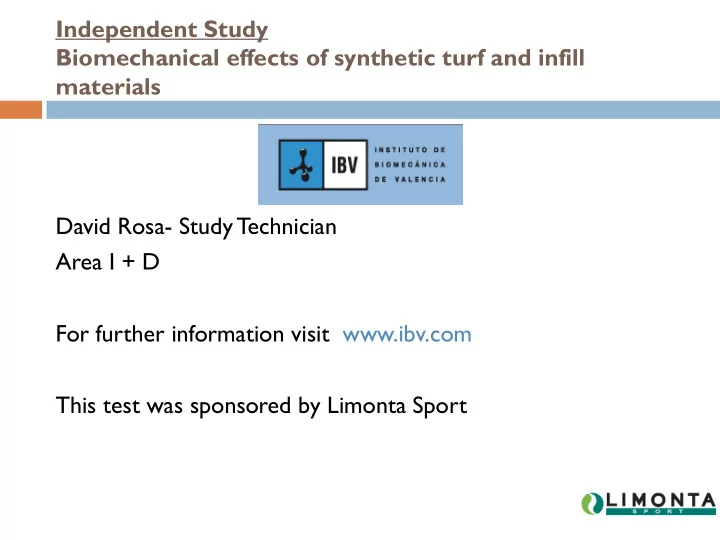

Independent Study Biomechanical effects of synthetic turf and infill materials David Rosa- Study Technician Area I + D For further information visit www.ibv.com This test was sponsored by Limonta Sport
BIOMECHANIC ASPECTS OF THE TURF
History of The Artificial Grass Artificial grass was developed in the 60’s as a substitute for natural grass with the objective of solving maintenance problems, especially in covered facilities In 1966 the first artificial turf was installed in the Astrodome of Houston(Texas) for the football league, and in 1971 artificial turf was installed in Caledonian Park (U.K.)
History Of Artificial Grass First generation of FIFA publishes the IFBA(International FIFA publishes synthetic grass with first “Quality Football Association “Quality Concept” stuffed sand and Concept” for Board) includes (FQC) for synthetic rubber synthetic grass synthetic grass like grass,**=UEFA game surface 1997 1998 2001 2002 2003 2004 2005 UEFA UEFA UEFA accepts FIFA & UEFA synthetic publishes a synthetic unify criteria grass studies manual for grass for the begin synthetic official grass competitions 2005/2006 Disagreement FIFA-UEFA: Installations Agreement FIFA-UEFA. FIFA is in charge of homologations and generation of test should be tried under two different equipments. UEFA is in charge of the medical criteria's based on the type of panels and biomechanic studies that allow to competition generate criteria
Function of the ground in the sport activity T echnical Function: -Property of the layers support : drainage, planimetry and lifting capability -Irrigation Systems -Durability of the fiber -Maintenance necessities Sport Function: -Absorption of impacts: Reduction of force and deformation -Stability in the footstep -Traction
Biomechanic Aspects
Sport Function: Absorption of Impacts Def: Is the capability that the ground has to protect the body from impacts -Eliminate high frequencies Without cushioning -Reduce strength cushioning
Sport Impact: Absorption of Impacts What occurs when an impact takes place? The impact is transmitted through the body like a vibration that cant be controlled by the muscles or tendons 1.5 1 Aceleracion (m/s2) 0.5 (Acceleration) 0 -0.5 1.3 1.35 1.4 1.45 1.5 1.55 1.6 1.65 1.7 1.75 1.8 (Time) Tiempo (s) Causes problems : -Discomfort , pain in knee and back
Sport Function: Absorption of Impacts Levels of Impact in different sports Baloncesto Modalidades deportivas S Aterrizaje Gimnasia P O R Salto de Altura T Triple Salto M O Salto de Longitud D A L Velocidad con clavos I T Carrera I E S 0 5 10 15 x peso corporal (Corporal Weight) Translation: Baloncesto(Basketball) Aterrizaje Gimnasia(Gymnastics) Salto de altura (High jump) Triple Salto(Triple jump) Salto de longitud(Long jump) Velocidad con clavos(Speed with nails) Carrera(Race)
Sport Function: Absorption of Impacts
FIFA regulation. Damping and Deformation of Artificial Grass Damping Deformation FIFA *55-70% FIFA*4-9mm FIFA**60-70% FIFA**4-8mm
Sport Function: Stability Importance Instability can cause movements you will articulate unexpected producing injuries, mainly on the ankle It also relates with discomfort & fatigue like in sand sports
Stability Studies Tests with studies Studies with soles: measuring the soles distribution of pressures
Stability: Grass Study Result from the measurement of sole pressure (Sole pressures ) Patrón de presiones plantares 1000 PROFESIONALES 900 AFICIONADOS 800 700 Presiones (kPa) 600 (Pressures) 500 400 300 200 100 0 TLE TLC TLI PLME PLMC C5MT C1MT MTM RDD PRDD (Zones of the foot) Zonas del pie
The Study
Material & Methods: Biomechanic Study Definition of Gestures: Gesture 1: Race at slow speed or trote Gesture 2: Jump Fotocélulas 5 repetitions of each subject -5 test subjects 6 m 3 m 0.35 m
Methods & Materials: Biomechanic Study Identification of Synthetic Grass Synthetic Elastic Pile Sand(KG) InfillType Infill Grass Type Layer(MM Height weight ) (MM) ( KG/Meter ) 1 --------- 60 18 SBR 14 2 25 45 4,5 GEO 9 3 25 45 20 SBR 8
Results: Biomechanic Study Damping of Impacts -Acceleration in head -Maximum angle support -Maximum flight angle Stability Maximum pressure per sections of the foot
Results
Results.Biomechanic Study Accelerations in the tibia bone. Slow Race. (Estimated Marginal Measures of the tibia bone) (Synthetic Grass) (Estimated Marginal Averages) (Subject)
Results.Biomechanic Study Acceleration in the head. Slow race. ( Estimated Marginal Measures of the head) (Synthetic Grass) (Estimated Marginal Averages) (Subject)
Results. Biomechanic Study Angle of support. Slow race. (Estimated Marginal measures of maximum angle of support) (Synthetic Grass) (Estimated Marginal Measures) (Subject)
Results. Biomechanic Study Angle of support. Slow race. (Estimated Marginal Measures of maximum angle of speed) (Synthetic Grass) (Estimated Marginal Measures) (Subject)
Result: Biomechanic Study 28 26 Acceleration in jump 24 22 Acel. tibia (g) 20 18 (Acceleration in Tibia bone) 16 14 12 10 1 2 3 ( Synthetic Grass ) Pavimento
Results: Biomechanic Study 9 8 Acceleration in the head-Jump 7 Acel. cabeza (º) 6 5 (Acceleration in the head) 4 3 1 2 3 ( Synthetic Grass) Pavimento
Result: Biomechanic Study 60 58 Angle of the knee during the support-Jump 56 Ángulo máximo (º 54 52 50 (Maximum Angle) 48 46 44 1 2 3 ( Synthetic Grass) Pavimento
Result: Biomechanic Study (Synthetic Grass 1,2,3) Stability Distribution of foot pressure (Sole Pressures) ( Zones of the foot)
Results: Biomechanic Study (Synthetic Grass 1,2,3) Stability Distribution Pav-1 of foot pressure Pav-2 (Sole Pressures) Pav-3 (Zones of the foot)
Conclusion
Conclusion: Biomechanic Study Synthetic Grass filled with GEO provoke less accelerations then synthetic grass filled with elastic cover and other fillings Less levels of impact are seen in the phase of support in the knee of the athletes
Conclusion: Biomechanic Study The jump studies, haven't generated any change in the behavior of the synthetic grass That’s why we can conclude that in a slow race, synthetic grass with elastic layer are provoking levels of impact
Conclusion: Biomechanic Study The distribution of sole pressure lets us verify that in slow races synthetic grass provokes less pressure is number 3 (synthetic grass with elastic layer and filling SBR) For the jump, the distribution of sole pressure lets us verify how provoked pressures in the sole are less for synthetic grass 2( synthetic grass with elastic layer and filling GEO).
Study Concluded www.limontasport.com
Recommend
More recommend